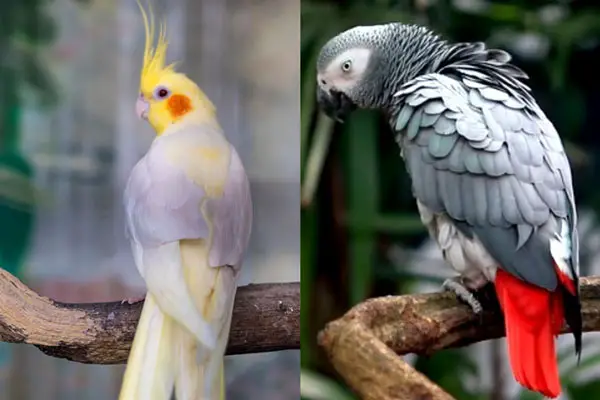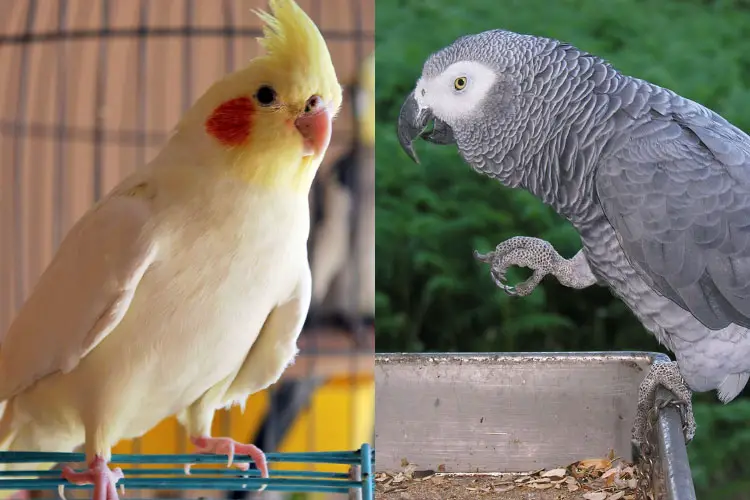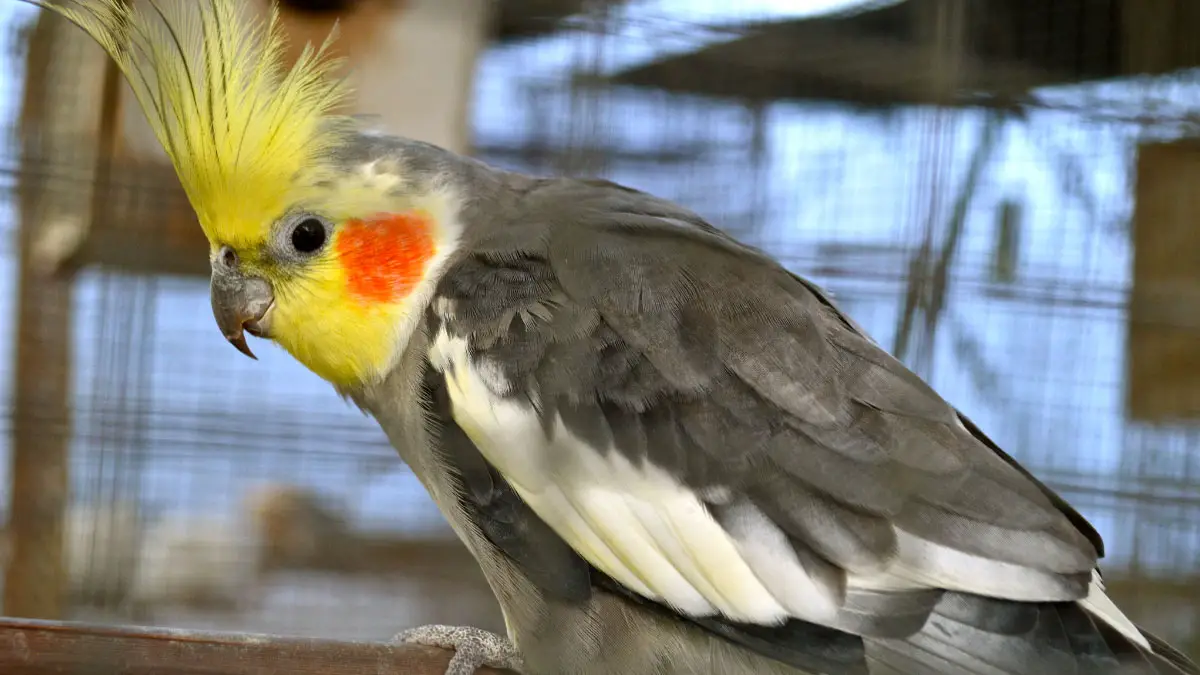Cockatiels and African greys are talented birds you can choose as your pet bird. But before nurturing them, you should know their identification, differences, and similarities.
The Australian cockatiel is a medium-sized parrot, and they are loving pets that whistle and scream. African Grey is also the best medium-sized talking parrot, and they are known as Old World Psittacidae parrots. Besides that, there are so many other fascinating facts that you are still unknown with.
In this informative article, we will share some must-know information based on the identification, differences, and similarities between these two species. Let’s go into the details!
Cockatiel VS African Grey
When it comes to finding a pet parrot, cockatiels and African greys are the two most popular options. As a result, bird lovers need information before adopting birds from pet stores.

Many of the creatures here are quiet, while others are pompous. One will make authentic voices, but others will create conversational tones. For a better understanding, let’s see their differences and similarities.
Differences and Similarities of Cockatiel and African Grey
| Differences/Similarities | Cockatiel | African Grey |
| Family | Cockatoo | Psittacidae |
| Lifespan | 10+ years | 25+ years |
| Breed | Easy to breed | Easy to breed |
| Weight | 400gms (14 ounces) | 85-90gms (3 ounces) |
| Size | 12 inches | 13-15 inches |
| Temperament | Friendly with human | Friendly with human |
| Nutrition | Pellets Vegetables Freshwater Seeds & Treats (small portions) | Pellets Vegetables Freshwater Walnuts Fruits |
| Health Issues | Liver disease Obesity Infectious to bacteria, viruses, and parasites | Allergies Obesity Fungal infections May get parasites |
| Vocal | Talk Sing Whistle Mimic sound | Imitate the sound Associate with human voices |
| Minimum Cage Size | 2ft width x 2ft long x 1.5ft height | 3ft width x 2ft long x 4ft height |
Similarities: Cockatiels and African grays are generally easy to breed, and they both remain happy with their breeding set-up. Another similarity between these birds is their temperament. They are very friendly and easily bond with humans. So they are both popular choices for keeping pets.
Differences: Although cockatiels and African grey have some similarities in behavior, but they have some differences too in their family, lifetime, weight, size, nutrition, health issues, and vocal and cage sizes.
Suppose; the cockatiel belongs to its own branch of the cockatoo family that is indigenous to Australia. However, the African grey is an Old World parrot belonging to the Psittacidae family.
Cockatiels often live more than 10 years in captivity, whereas African gray parrots live longer than average- they can live for more than 25 years in a cage.
Although both are medium-sized birds, cockatiels measure 400 grams while African grays measure 85-90 grams weight. Thus, African gray parrots tend to have larger cage sizes than cockatiels. You can also find a few differences in their nutrition, health issues, and vocals.
Besides that, they both are excellent pets individually.
Identification of Cockatiel
Suppose you need a better understanding of male or female cockatiel color patterns, color mutations, and cockatiel behavior. In that case, you’ll probably be able to find out the identification of your bird sex once you know these facts.

1. Color Pattern
Cockatiels can be identified as male or female after their first molt, which occurs between six and nine months. The following traits apply if your pet bird is white-faced, plain grey, cinnamon, chubby, or silver-colored.
Male Cockatiel:
- Male cockatiels have brilliant orange cheek patches and solid yellow faces.
- White-faced male cockatiels have white faces.
- Their tiles lose their tail and wing spots in their first molt.
Female Cockatiel:
- Female cockatiels have grey or tan faces with a touch of yellow.
- Orange cheeks are typical if they have a sweet white look.
- They retain the kids’ tail, wing feather patches, and grey and yellow barring.
2. Color Mutation
This category includes Pied, Lutino, Yellowface, Pearl, Pastel Face, and Albino variants. These various color mutations make tiles more visually appealing. However, with other mutations, you must rely totally on other signs.

Pied:
- Female faces are yellower and more vibrant in hue, and they can have blemishes on their cheeks. Their pied tiles have barred tails, and most pied tiles with a light grey area on their face are known as “dirty-face pieds.”
- If they are male birds, they can change their yellow masks, with black tails and no bars.
Lutino:
- Female lutinos typically retain the banding on their tail, albeit in a fainter form.
- If the cockatiel is a lutino pied, the barring may be absent, and other inspections may be required to identify the gender.
Yellowface:
- Yellowface cockatiels lack cheek patches, but their other color patterns resemble greys.
- Male cockatiels will have yellow heads with no barring, but females will have predominantly grey faces with no barring.
Pearl:
- Males cockatiels will lose their pearled markings during their first two molts, transforming them into typical males.
- Female pearl tiles retain their pearled marks, and males with pearlings may keep part of their pearling.
Pastel face
- Male cockatiels will not have cheek spots that are noticeably brighter in color than female cockatiels, but all other color patterns will be different.
Albino
- Whiteface Lutino is another name for Whiteface Lutino. If your bird has black eyes and a pure white body, it’s a pure pied cockatiel, not an albino.
3. Behavior Differences
Individual cockatiels will behave differently. However, some generic insights can frequently assist you in determining whether your pet bird is male or female.

Female:
- Female cockatiels contain more passive characters than male cockatiels.
- They are less likely to sing.
- When she wants to mate, she will tilt her head and rock back and forth.
Male:
- Male cockatiels are more vocal.
- They like to mimic and show off.
- When their hormones are active, they even try to mate with a toy.
4. DNA testing
If you are still unsure about your cockatiel’s identity based on color patterns, color mutations, or behavior, you can get a DNA test performed.
Identification of African Grey
African grey breeders and owners think it is simpler to distinguish the slight distinctions between males and females. Male African grey tail feathers are entirely red, whereas female red tail feathers are silver tipped. However, tail feathers cannot be used to identify gender unless your grayling is at least 18 months old.
Exterior gender disparities are generally not dependable. Experienced breeders can detect the modest size and color differences between the genders of their breeding birds. However, this is a highly subjective and unreliable method of determining sex.

In conclusion, if you’re still stuck about your grey pet’s gender, here are some most prevalent clues that can aid you in determining its gender based on its appearance or outer look. Otherwise, you will need to make the gender identification of African grey.
Female African Grey
- African Grey female birds are typically smaller than 12-14 inches in height.
- Female African Grey have elliptical and thin bodies.
- Their necks are long; their heads are larger and more rounded.
- Female African Grey birds have rounder eye patches.
- The tail feathers of the female African Grey bird are red, although they can also be silver.
- Female African Grey underbelly feathers will be light grey.
Male African Grey
- Male African Grey birds are typically greater in size, approximately 12-14 inches tall.
- They have shorter necks than female African Grey Parrots.
- These birds have a little flatter head.
- The male African grey parrot has a rounded physique.
- Male African Grey Parrot’s tail feathers will be completely red.
- They have dark grey underbelly feathers.
- These birds have pointy eye patches.
Cockatiels vs Parrots—Which bird is better?
Parrots and cockatiels are adapted to diverse lifestyles regarding friendliness and preferences as pets. Cockatiels are peaceful, quiet, and easygoing birds that bond well with humans if they are hand-fed. Before interacting with their pet owner, parrots go through a lengthy adjustment process.

FAQs
If you have more queries on the topic, check out the FAQs to see if it answers yours.
Pairing a cockatiel with an African grey will likely work, and they can coexist quietly if your parrot likes your cockatiel. However, if your African grey dislikes the cockatiel or becomes a bit aggressive, it can cause terrible harm to this small bird.
The cockatiel polled in at the top with 61% of the vote. The intelligence of the African grey was widely praised. The African grey may be a good choice if you’re looking for a bird that takes more of your time and energy than a typical pet would. On the other hand, the cockatiel is an excellent choice if you want a smart pet bird to show off to your friends.
Outro
Staying with a pet bird is a delightful and sometimes challenging experience, particularly if you want to adopt a cockatiel or an African grey as a pet. If you can’t decide between these two bird species, read the complete article for more information.
You will learn about cockatiel vs African grey: identification, differences, and similarities based on their personalities and appearances. Once you have all this information, it will be easier for you to make the right decision about your pet adoption.







